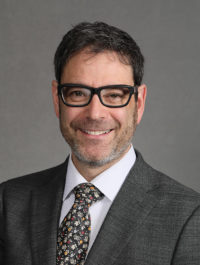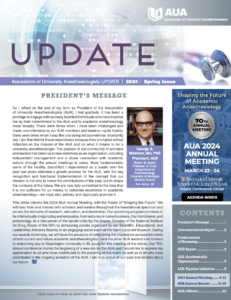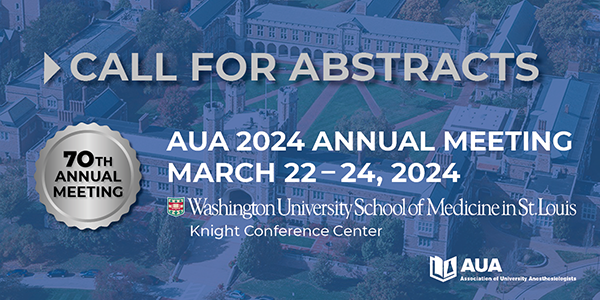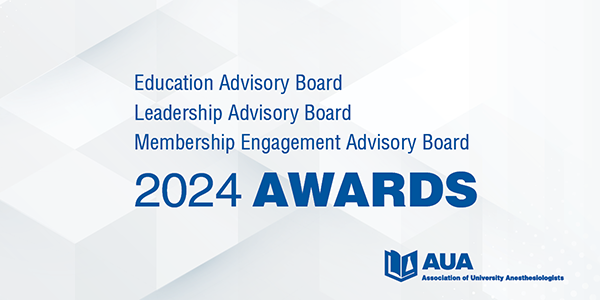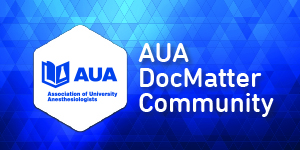A Time of Flux and of Opportunity for the AUA
Healthcare is experiencing a time of major flux, and, now more than ever, academic leaders in anesthesiology have the opportunity and obligation to provide direction to the field. There are several readily identifiable major concerns that are highly relevant to the AUA. The first is that there is currently a dearth of academic leaders in anesthesiology in the US. There are several reasons for this, including that during the period from about 1995 to 2005 very few highly accomplished medical graduates chose to specialize in anesthesiology. Fortunately, this has changed dramatically in recent years. But there remains a ‘missing generation’ of academic anesthesiology leaders in the US. Second, healthcare around the world is becoming too expensive. Academic leaders and researchers must consider how we can deliver better care at lower costs, with improved patient outcomes. Harnessing new technologies, including telemedicine and machine learning, are likely to be central in helping to accomplish these lofty goals. Third, we must address scientific questions that matter beyond the parochial interests of our specialty, and that contribute substantially to advancements in health and knowledge. Academic anesthesiology must pursue team science and ensure that we remain relevant in a broader context. Fourth, is a point that has been highlighted by several researchers, but has not appreciated in the medical community, by society or even by anesthesiologists. Surgery is very dangerous. In fact, it is estimated that over 4 million people die annually in the early postoperative period. Elective surgery is one of the leading causes of major morbidity and mortality around the world. Academic anesthesiologists must ensure that this public health challenge is appreciated and that we lead the charge in addressing it.
Considering these and other challenges and opportunities, the AUA Council is proposing that the AUA update its Mission and Vision. The proposed new Vision of the AUA is “the furtherance of anesthesiology as a dynamic academic medical specialty, with a vibrant community of successful scientific, educational and medical leaders within the academic sector.” And the proposed new Mission of the AUA is to bolster academic anesthesiology through:
- deliberate mentorship of academic anesthesiologists, under the rubric of faculty development;
- programmatic and ongoing career development of anesthesiology researchers, educators, and academic leaders throughout their careers;
- the organization of an outstanding annual academic meeting;
- targeted provision of networking opportunities to academic anesthesiologists.
In keeping with this reconceptualization, one cardinal new goal that the AUA is embracing, is leadership development within our field. As part of this focus, the AUA is prioritizing the mentorship of rising academics in anesthesiology, and support of initiatives such as the early stage anesthesiology scholars (www.esashq.org). We hope as the AUA to make a meaningful contribution to the training of the next generation of academic leaders in anesthesiology.
One of the important services to our members, and the broader academic anesthesiology community, is the provision on an outstanding annual academic meeting, which is also an explicit mission-based objective. This year’s meeting in Montreal has been thoughtfully planned to address several current research and educational priority areas. (https://auahq.org/aua-annual-meeting/sessions/) The host program includes talks on cannabis, music, pain, and the history of anesthesia in Montreal. Early stage investigators will feature in the president’s lunch and throughout the meeting. The president’s panel showcases research leaders from different backgrounds addressing the topic, “ The Reproducibility Crisis in the Era of Precision Medicine.” The Education Advisory Board has prepared outstanding sessions on self-regulation and on the science of effective feedback. And the Scientific Advisory Board has arranged high level presentations of new, cutting edge findings in anesthesiology science, as well as a compelling symposium on “Anesthesia and Consciousness.” Finally, on Sunday afternoon there will be the second annual meeting for the “Initiative for Multidisciplinary Pragmatic Anesthesiology Clinical Trials (IMPACT).” The AUA is aligned to the Society of Critical Care Anesthesiologists (SOCCA) and International Anesthesia Research Society (IARS). These organizations’ meetings will complement the AUA’s program and many of their offerings are likely to be of great interest to the AUA’s members. All three meetings will offer excellent opportunities for AUA members to provide mentorship to early stage colleagues and to network with academic leaders from around the world.
Ultimately, whether or not we as a specialty will be successful in meeting the challenges we face will to a large extent depend on the vitality of the academic anesthesiology enterprise across the United States and internationally. The AUA is an honorific organization, which provides a home to leaders in academic anesthesiology. But the AUA should be so much more than just an honorific talk shop. The AUA must also be actively engaged in activities intended to safeguard anesthesiology as a dynamic academic medical specialty, with a vibrant community of successful scientific, educational and medical leaders.
